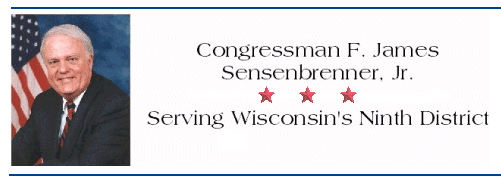












_

August 3, 2001 Raj Bharwani
569 Words (202) 225-5101
House Energy Bill Provides Light at the End of the Tunnel
After eight years without a coherent energy policy, the House voted on August 1, 2001, for a comprehensive energy plan to increase conservation and production while protecting the environment. H.R. 4, the Securing America's Future Energy (SAFE) Act, is the legislative portion of the President's comprehensive energy policy. It incorporates legislation from five committees of jurisdiction, and includes provisions on conservation, environmental regulations, alternative energy sources, and increasing production. It passed - with my support - by a vote of 240 to 189.
I voted for the SAFE Act because it is a comprehensive, balanced approach to energy policy that incorporates efforts to bolster the use of alternative and renewable forms of energy. It encourages conservation, improves our energy infrastructure, and develops traditional sources of energy within the United States. For too long, the U.S. has lacked a coherent energy policy, making our economy increasingly vulnerable to the whims of the Organization of Petroleum Exporting Companies (OPEC). High gas and home heating prices in Wisconsin earlier this year were evidence of that fact. Furthermore, last year, foreign imports of oil made up 52% of the nation's supply - close to twice the percentage of the 1970's. We must reduce this dependence on foreign oil and gas in order to help the U.S. economy. We can't be held hostage to countries like Iraq and Iran when it comes to a resource that is essential for this country to operate. If we don't pursue our options for oil exploration in the U.S., we could be crippled by countries that would love to be in a position of control. H.R. 4 represents a solid first step to reduce this dependence.
H.R. 4 includes several provisions that offer help to Wisconsin’s
energy prices. For example, as a step in the right direction, it
addresses the problems associated with the use of the multitude of
“boutique” fuels, which are used across the country. As a result of
the numerous regulations placed on the sale of gasoline, there are a great
variety of blends of gasoline sold across the
country. These
"boutique" fuels place a great strain on the production and distribution
of gasoline because these different blends of gasoline often cannot be
used in more than one region. Instead of having different counties
and states using different blends of gasoline, we must work toward lifting
these restrictions and allowing various regions around the country to use
more uniform gasoline blends.
H.R. 4 also calls for a re-evaluation of the regulations governing the
switch from winter-blend to summer-blend gasoline. The present
regulations have contributed to the steep gasoline price spikes seen in
the spring in Wisconsin for the past two years. Additionally, the
energy bill includes $33.5 billion in tax cuts and incentives over ten
years to encourage the harnessing of
cleaner sources of energy like
solar, wind, energy created using landfill gas, and other
renewables.
H.R. 4, the SAFE Act, is a good bill for the nation, for Wisconsin, and for the environment. Our current energy problems are the result of numerous factors and demand a multi-faceted solution. There is no simple one-size-fits-all solution to these problems, but this energy bill, by taking a balanced and comprehensive approach, offers us all the opportunity to consider a national energy strategy for the first time.
###
